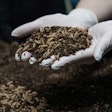Species-specific breakout sessions at BIOMIN’s World Nutrition Forum reveal similarities, challenges
Last week, I attended BIOMIN’s 2014 World Nutrition Forum, held in Munich. The three-day affair attracted 800 attendees from 86 countries. I left Munich with much to think about: newfound knowledge, article leads, questions to follow up on, and new contacts.
One of the strengths of international events lies in the opportunity for information and idea exchange among peers – as well as interactions which often reveal similarities in production and nutrition challenges across continents. On the second day of the event, attendees where given the option to choose one of four species-specific breakout sessions.
Each session was comprised of eight brief presentations which ranged from trends-based reports to scientific research.
I split my time between swine and aquaculture. However, for the purposes of this blog, I’ll focus on the swine session.
Regional commonalities
In the commercial session, titled “Different regions – similar challenges,” four presentations revealed commonalities in pig production in four countries: China, South Africa, Latin America and Denmark. For example, the growing human population and the allocation of grains for human consumption will continue to the raise the cost of feed ingredients. In addition, each region pointed to the issue of grain quality as it relates to the negative effects of mycotoxins and the ongoing controversy about genetically modified grains.
In each region, the environment and animal welfare have becoming increasingly more important across the board.
There are cultural and religious factors swaying the preferences of particular regions, e.g. in some countries pork consumption is low compared with poultry and beef. The speakers suggested they “need to find solution to this challenge” through export and education efforts.
Improved gut performance
The issues tackled in the second track, “Gut health is the best growth promoter,” focused on the scientific and nutrition-based means of achieving the best outcomes in swine production. As the name suggests, it was agreed that the key to better – and sustainable — performance lies in a pig’s gut and gastrointestinal tract matched with genetic improvements.
Everyone knows a healthy animal saves money with the FCR. Consequently, the consensus was that it is of the utmost importance to protect and improve gut health – most importantly doing so without the unnecessary use of antibiotics. As such, the inclusions of alternative growth promoters, such as phytogenics, organic acids, probiotics and prebiotics, will continue to grow; as well as the interest in the ability of enzymes to increase digestibility
Additive inclusions stand alone, but are a component of a wider feeding schema. Aside from the problems and conditions stress can cause, ingredient quality and its effects on feed digestibility play their part in ensuing the performance and health of the animal. Mitigating the risk of mycotoxins and “deactivating” their potential to harm the animal continues to be a major area of interest for producers, researchers and nutritionists.
BIOMIN’s focus moving forward
Incidentally, the conclusions reached during the swine breakout session align with BIOMIN’s strategic “rethinking” of its focus for the future. According to the company’s CEO and director of its executive board, Andreas Kern, BIOMIN will be focusing its efforts on two core competencies: mycotoxin risk management and gut performance.
He specifically referred to the successes of EU registrations of two mycotoxin products: Mycofix Secure (binder) and Biomin BBSH 797 (detoxifier), and on the gut performance front, PoultryStar (multi-strain probiotic).
“To meet his demand we need to expand different research facilities because the products need a certain support and will help us to better develop and improve services to customers,” Kern says. “Also it helps to bring production and logistics closer to our customers.”
The company will invest in new production facilities in China (with two production lines) and Panama (logistic and production center for Central American markets). It has also set up new business units in Myanmar, New Zealand and Japan.













